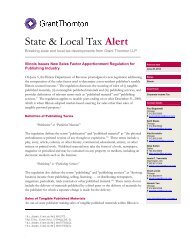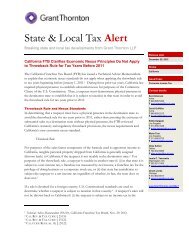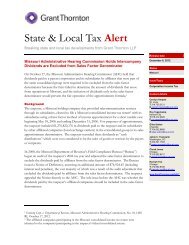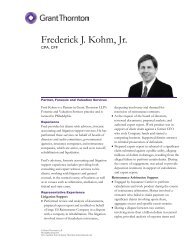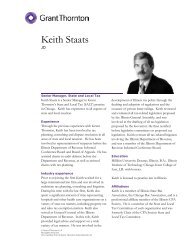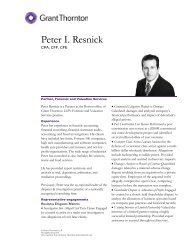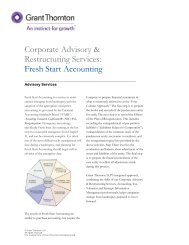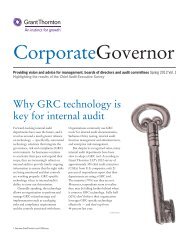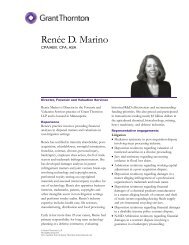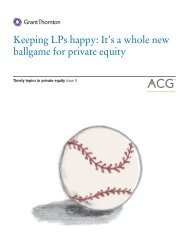Market Structure Redux - Grant Thornton LLP
Market Structure Redux - Grant Thornton LLP
Market Structure Redux - Grant Thornton LLP
Create successful ePaper yourself
Turn your PDF publications into a flip-book with our unique Google optimized e-Paper software.
<strong>Market</strong><br />
<strong>Structure</strong> <strong>Redux</strong>:<br />
Can the Capital <strong>Market</strong>s Be Re-Formed on a Broken Foundation?<br />
The Making of an Endowment CIO<br />
GWU’s Lindsey Takes a Thematic Approach<br />
Canadian Capital <strong>Market</strong>s Recap<br />
Change, Challenge and Competition<br />
The Scarlet Letters of TARP<br />
Banks Line Up to Return Bailout Funds<br />
Futures Vs. Options<br />
Two <strong>Market</strong>s Remains Riddled in Complexities<br />
september/october 2009 marketsmediaonline.com<br />
2009<br />
National Editorial<br />
AWARD WINNER<br />
pg.63
cover section<br />
<strong>Market</strong><br />
<strong>Structure</strong> <strong>Redux</strong>:<br />
Can the Capital <strong>Market</strong>s Be Re-Formed on a<br />
Broken Foundation? The U.S. loses global ground<br />
as it falls further behind other developed nations<br />
that create a fertile environment for public<br />
companies to grow.<br />
By Natasha Gural, Editor-in-Chief<br />
The proliferation of high-frequency electronic trading and<br />
well-intended regulatory changes have led to a flurry of unintended<br />
consequences that have fundamentally changed,<br />
and arguably crippled the market structure, hindering capital<br />
formation. Venture capitalists and private equity firms have been<br />
pummeled as dealmaking dried up in a marketplace where a lack<br />
of Wall Street research combines with the impact of these regulatory<br />
changes and a speed-driven electronic trading arms race<br />
to prohibit small and mid-cap companies from going public. The<br />
uber-efficient markets in the U.S. have subverted the model of<br />
long-term investing, creating a need to feed the speed with technology<br />
and services, while providing no protection for those with<br />
an outlook for growth.<br />
“I think that there are several regulatory<br />
changes that have taken place since<br />
the mid 1990s that have all conspired to<br />
create perfect storm that is leading us to<br />
where we are.” – Paul Deninger, vice chairman<br />
of Jefferies & Company<br />
Those seeking to repair the broken market structure point to<br />
a host of actions that have forever transformed the landscape,<br />
including: decimalization, which slashed trading revenue for investment<br />
banks; deregulation of commission rates; the investment<br />
banking consent decree, which pays research analysts with trading<br />
revenue; the elimination of banking syndication, which allows<br />
bookrunners alone to decide where all shares are placed; a lack of<br />
Wall Street research for small and mid cap companies; Reg NMS;<br />
and the unintended consequences of Glass-Steagall, including the<br />
consolidation of boutique banks, which has left underwriters no<br />
choice but to focus only on very large clients.<br />
“I think that there are several regulatory changes that have<br />
taken place since the mid 1990s that have all conspired to create<br />
perfect storm that is leading us to where we are,” Paul Deninger,<br />
vice chairman of Jefferies & Company, tells <strong>Market</strong>s Media.<br />
A growing chorus is clamoring for change, with some suggesting<br />
the creation of a secondary market to support smaller companies.<br />
“It would be particularly important to repair (the market structure)<br />
in these times of economic stress, and the way to repair the<br />
market for smaller cap stocks and IPOs is to create a parallel market<br />
that would co-exist with the current public market,” Michael<br />
Halloran, a partner with Kilpatrick Stockton and a former counselor<br />
to the chairman and deputy chief of staff at the Securities<br />
and Exchange Commission, tells <strong>Market</strong>s Media.<br />
2<br />
marketsmedia magazine I september/october 2009
David Weild, founder of Capital <strong>Market</strong>s Advisory Partners, senior<br />
advisor at <strong>Grant</strong> <strong>Thornton</strong> and former vice chairman of the<br />
Nasdaq, has long been aware of the mounting problems and advocates<br />
the creation of a parallel public market (and improvements<br />
to the private market) to support small capitalization companies<br />
and with them, IPOs and other financings that will drive economic<br />
growth and job formation.<br />
“The last time I looked it was investors who support economic<br />
growth, not high-frequency traders. At the end of the day Congress,<br />
the SEC and the exchanges must fix our market structure for the<br />
sake of the U.S. economy. The silence is deafening. When are<br />
we going to wake up to the reality that the IPO market has been<br />
crippled by changes in market structure? The problem might have<br />
lost its best natural watchdogs, the stock exchanges, when privatization<br />
of the exchanges took them from member-owned organizations<br />
to public companies that need to grow earnings,” Weild tells<br />
<strong>Market</strong>s Media.<br />
Weild adds: “The exchanges now focus on increasing trading<br />
volume, capturing trading volume and making geographic and<br />
product acquisitions. The core small company listings business<br />
has taken a back seat. At the same time, with the repeal of Glass-<br />
Steagall back in 1999, the investment banks have consolidated<br />
and become so big that the important ones can’t afford to care<br />
about small companies anymore. The bigger the exchanges become,<br />
the more they need scale to grow earnings by competing<br />
for trading market share and creating instruments that will trade<br />
in large volumes (for example, ETFs, derivatives, etc.) rather than<br />
focusing on smaller companies that will help grow the economy.<br />
Exchanges must answer to their shareholders rather than<br />
the health of the larger ecosystem.”<br />
U.S. Senator Ted Kaufman has urged the SEC to review<br />
seven stock market practices, saying the developments<br />
such as high-frequency trading may erode<br />
the confidence of investors.<br />
“I am concerned that questionable practices<br />
threaten to further erode investor confidence in<br />
our financial markets and that our understanding<br />
and regulatory capacity have not kept pace<br />
with those changes,” Kaufman wrote on Aug.<br />
24 in a proposal to SEC Chairwoman Mary<br />
Schapiro. “The current market structure<br />
appears to be the natural consequence<br />
of regulatory structures designed to increase<br />
efficiency and thereby provide<br />
the greatest benefits to the highest<br />
volume traders.”<br />
Kaufman says he’s concerned<br />
that the SEC rules favor high speed<br />
liquidity over execution fairness,<br />
noting that on Aug. 21, just four of<br />
the more than 5,000 stocks in the<br />
U.S. equity market; Citigroup, Bank of<br />
America, Fannie Mae and Freddie Mac<br />
contributed 20 percent of the volume.<br />
He says rules meant to strengthen<br />
public order display instead have led<br />
to the proliferation of dark pools.<br />
Rules have spurred competition with the exchanges, leading to 50<br />
or more execution venues.<br />
“This has led to increased competition for market share, however,<br />
that now includes questionable practices such as liquidity<br />
rebates, flash order offerings, co-location of servers and other inducement<br />
arrangements with broker-dealers and other market participants,”<br />
Kaufman wrote.<br />
<strong>Market</strong> <strong>Structure</strong>’s Broader Impact<br />
In an upcoming whitepaper with the working title “A wake-up call for<br />
America: Evidence of the systemic failure of the United States stock<br />
markets” co-authors Weild and Edward H. Kim, also a senior advisor<br />
to <strong>Grant</strong> <strong>Thornton</strong>, argue that while market structure in the United<br />
States may be working for large capitalization companies, it is systematically<br />
degrading the value of small capitalization companies.<br />
“<strong>Market</strong> structure has a very significant impact on capital formation,<br />
because from the venture capital standpoint we have to<br />
answer two basic questions: what are the metrics that are required<br />
in order to achieve a public market exit and are those metrics feasible?<br />
Eleven years ago it would take six and half years on average<br />
for a company to be IPO worthy,” Pascal Levensohn, founder and<br />
managing partner of Levensohn Venture Partners, tells <strong>Market</strong>s<br />
Media. “Now we’re north of 10 years. The problem with that is the<br />
market structure has shifted so that the median time to a public<br />
market exit now exceeds the life of the VC partnership making the<br />
investment. It’s a systemic dysfunction.”<br />
San Francisco-based LVP manages more than $200 million<br />
in committed capital and currently has two active venture capital<br />
funds focused on information technology companies, emphasizing<br />
digital media, security and demand-side cleantech. As venture<br />
capitalists like Levensohn look toward cleantech as the new boon,<br />
the systemic problems are clogging pipelines and effectively blocking<br />
the dealmaking process.<br />
“Either partnership lives have to change, or capital markets<br />
have to change,” says Levensohn. “The question is: Is it reasonable<br />
for it to take 10 years for a venture-backed company to go<br />
public? I say no,” says Levensohn. “Goldman or another large investment<br />
bank would say capital markets are healthy as long as<br />
you raise $150 million in IPO money at a market valuation in the<br />
range of $500 million. That effectively excludes 90 percent of all<br />
venture companies.”<br />
Lawrence Leibowitz, group executive vice president and head<br />
of U.S. markets and global technology at NYSE Euronext, tells<br />
<strong>Market</strong>s Media: “I think there a lot of things that can be fixed<br />
about the current market structure, but I don’t think it has any<br />
impact on the broader economy.”<br />
“I don’t think the market structure currently has any bearing<br />
on the IPO market. The reason the IPO market has problems is<br />
because the economy hasn’t been good,” says Leibowitz. “If the<br />
economy improves, which it already has, we will see the IPO market<br />
improve. It has nothing to do with the trading structure as far<br />
as I can see.”<br />
But Levensohn, Weild and Mark G. Heesen, president of the<br />
National Venture Capital Association, say the de-listing of public<br />
companies and the collapse of IPOs create a major impact on the<br />
broader economy through the loss of jobs, both on Wall Street and<br />
Main Street.<br />
marketsmedia magazine I september/october 2009 3
cover section<br />
<strong>Market</strong> <strong>Structure</strong> <strong>Redux</strong> I continued<br />
“It’s just the tip of the iceberg as<br />
these companies go public and keep<br />
growing. These companies are often<br />
acquired for one technology, but their<br />
entrepreneurial spirit gets stripped<br />
out and that will ultimately impact our<br />
national and international economy.”<br />
– Mark G. Heesen, president of the National<br />
Venture Capital Association<br />
“Statistics show that 90 percent job creation of venture<br />
backed companies occurs post IPOs. (Job creation) will not occur<br />
if we don’t get IPOs back, period, full stop,” says Levensohn.<br />
Heesen cites an NVCA study which found that 92 percent of<br />
job growth in companies occurs after they go public.<br />
“It’s just the tip of the iceberg as these companies go public<br />
and keep growing. These companies are often acquired for one<br />
technology, but their entrepreneurial spirit gets stripped out and<br />
that will ultimately impact our national and international economy,”<br />
Heesen tells <strong>Market</strong>s Media. “It takes 10 years to go public.<br />
You have to have the patience to wait that long. In this environment<br />
investors say they want to see a check. We really have to look<br />
at the idea of shepherding these small companies that [have the<br />
potential to] become major companies down the IPO route.”<br />
Contagion Spreads<br />
Venture capital investment plunged 51 percent in the second<br />
quarter as the lingering recession and the IPO dearth drove down<br />
funding for startups to a 15-year low. VC firms invested $3.67 billion<br />
in 612 financing deals during the quarter, down from $7.56<br />
billion a year earlier, according to PricewaterhouseCoopers and the<br />
NVCA. Just 141 startups had a first round of venture funding, the<br />
lowest number since 1994. Industry tracker Dow Jones Venture-<br />
Source said venture capitalists invested $5.27 billion in 595 deals<br />
in the second quarter, a 32 percent jump over the first quarter of<br />
2009, but still lower than the $8.33 billion put into 726 deals<br />
during the second quarter of last year.<br />
Startups are expected to raise some $15 billion in capital this<br />
year, according to the PwC/NVCA report, compared with $30.6<br />
billion in 2007, the NVCA said. Heesen says just six U.S. startups<br />
have gone public this year, and just 10 U.S. companies have pre-<br />
IPO paperwork on file with regulators.<br />
“We’ve already seen a dramatic drop in venture capital formation.<br />
The amount of money raised and put into funds this year is a<br />
third of last year and going down like a rock,” says Halloran, who<br />
also previously served as served as group executive vice president<br />
and general counsel for Bank of America. “It makes the bigger<br />
companies realize they do not have to pay as much to acquire a<br />
smaller company because the big companies are the only avenue<br />
for liquidity. When venture capital returns decline, venture capital<br />
needs to ask for a bigger chunk of companies. So it’s like a waterfall<br />
effect in the sense that venture capital funds are raising less<br />
money, fewer companies are getting invested in, and when they are<br />
getting invested in, they have to give up more equity.”<br />
Halloran says “fewer sales of companies translates into fewer<br />
sales to markets which ultimately leads to smaller markets, which<br />
ultimately leads to a real economic problem. It’s going to be a national<br />
issue; ultimately we will realize that we are slowly but surely<br />
eating our tail in the name of cheap commissions and restrictions<br />
on research analysts. The lion’s share of the jobs in this country<br />
are, believe it or not, in the smaller companies, and it’s already<br />
having an impact on the job market and that will continue.”<br />
The Obama administration believes that economic recovery will<br />
be driven in large part by America’s small businesses, which have<br />
generated about 70 percent of net new jobs annually over the past<br />
decade, according to the Treasury.<br />
In the private sector, more than half of all Americans are employed<br />
by small companies, with less than 500 employees, according<br />
to the Small Business Association. According to the ADP National<br />
Employment Report, nonfarm private employment at large<br />
businesses, defined as those with 500 or more workers, declined<br />
by 74,000, while employment at medium-size businesses with between<br />
50 and 499 workers declined 159,000 in July from a year<br />
ago. Employment among small-size businesses, defined as those<br />
with fewer than 50 workers, declined 138,000. Since reaching<br />
peak employment in January 2008, small-size businesses have<br />
shed nearly 2.4 million jobs.<br />
As the clamor for consolidation continues, firms that are delisted<br />
are not being replaced by new ones, leading to the “incredible<br />
shrinking market,” as Weild, Halloran and others call it.<br />
“In the long-term it will (destroy Wall Street) in<br />
the sense that the number of public company<br />
listings has declined dramatically since 1990,”<br />
says Halloran.<br />
4<br />
marketsmedia magazine I september/october 2009
The number of companies listed on the NYSE, Nasdaq and<br />
AMEX tumbled 22 percent from 1991 to 2008 year end, and<br />
tanked 44 percent from peak to trough in listing from 1997 to<br />
2008, according to Halloran.<br />
“And it will go still lower in 2009. Ultimately you have a tighter<br />
and tighter market [due to consolidation] that is dominated by<br />
larger and larger companies,” says Halloran. “Now companies<br />
[that are merged with others] are not replaced with new listings.<br />
Over time it will destroy Wall Street in the sense there will not be<br />
sufficient liquidity in the market other than a group of very large<br />
companies. Any IPO of less than a $250 million market capitalization<br />
company (and the number is probably higher) is a problem in<br />
terms of having enough commission volume to support research<br />
and the other activities to take a company public. Actually you<br />
probably shouldn’t go public without a market cap of less than<br />
$750 million. You won’t have an aftermarket to support your stock<br />
if you do.”<br />
According to VentureSource, median deal size continues to<br />
shrink, falling to $5 million in the second quarter from $8 million<br />
in the second quarter of 2008, and to its lowest level since<br />
1999. “As venture investors are forced to hold on to companies for<br />
longer periods of time, corporations are beginning to step in to<br />
help carry these companies down the last stretch to exits,” Jessica<br />
Canning, director of global research for Dow Jones VentureSource,<br />
said in a statement.<br />
“The broader impact would be that the companies will have to<br />
wait a lot longer to grow bigger to access the capital markets, and<br />
that means there will be less capital infusion into these smaller<br />
companies,” says Heesen. “It’s a self-feeding circle. If this continues<br />
for another three, four or five years, the overall capital markets<br />
and the economy will go into a further decline. The flipside is that<br />
if we get it fixed, the equity capital markets can begin again to<br />
make a real contribution to economic growth. Everything is supply<br />
and demand. If the lack of supply continues, the pipeline will shut<br />
and capital markets and those that support them will shut with<br />
them. Everyone will live to regret that the supply part of the equation,<br />
IPO supply, has virtually disappeared. Like with any other<br />
system, if you don’t have input, you don’t have output.”<br />
Venture capital investments in the international markets fell to<br />
the lowest level since 2003, with $1.46 billion invested in 250<br />
deals for emerging companies in Europe, Canada, Israel, China<br />
and India in the second quarter, tumbling 63 percent from $3.95<br />
billion invested in 452 deals during the second quarter last year,<br />
according to VentureSource.<br />
“It would be a mistake for us to continue to assess the relative<br />
health of the U.S. IPO market in a vacuum; we need to consider<br />
the global markets and consider America’s slipping global<br />
competitiveness. A deep hole of liquidity for emerging companies<br />
in the U.S. is only going to contribute to America’s deteriorating<br />
position,” says Levensohn. “The problem that a lot of people have<br />
is they are considering the implications in a very narrow way, and<br />
they are not considering the impact of one issue on another. The<br />
urgency of resolving this cannot be overstated.”<br />
Beyond Sarbox: The Real Regulatory Ruffles<br />
Pundits have been quick to blame Sarbanes-Oxley for the flight of<br />
IPOs from the U.S. to overseas, even as China and other developing<br />
countries clamor to support local capital markets.<br />
“A number of things have to be looked at. The SEC is going<br />
back and looking at Sarbanes-Oxley and the regulatory environment<br />
we’re in right now. A response on the SEC’s part is to ask if one size<br />
fits all. Should regulations to cure ills for Fortune 500 companies<br />
be subject to small companies? We need to review the regulations<br />
of the last 15 years, looking at things like the Spitzer settlement<br />
and decimalization,” says Heesen. “While large investment banks<br />
help the investor process, we should also look at fostering a new<br />
group of young investment banks on how to understand our technology.<br />
[We must look at] the idea of garnering large institutional<br />
investors [middle tier], the importance of holding assets over the<br />
long-term instead of changing daily and getting people interested<br />
in your company years before they go public. In terms of tax policy,<br />
it appears taxes will be going up in the next couple of years, and<br />
we need to make sure to reward long-term investment. That will go<br />
a long way to helping this situation. The venture industry is putting<br />
investors in front of companies that they are interested in.”<br />
Halloran acknowledges that Sarbox is “very costly” in terms of<br />
improving internal control over financial reporting, especially for<br />
smaller companies. “However,” he says, “it is not what has killed<br />
the IPO market in the United States. Sarbanes-Oxley didn’t come<br />
into being until 2002 and there is plenty of evidence that the<br />
IPO market was in trouble going<br />
back to 1997. I’ve more or<br />
less come to believe that you<br />
can amend the internal controls<br />
rules under Sarbanes-<br />
Oxley, but the accountants<br />
are going to spend a<br />
lot of money imposing<br />
their view of adequate<br />
internal controls – to<br />
protect themselves from<br />
liability. It’s a private<br />
industry matter.”<br />
“Sarbox is partly responsible<br />
in that it raises costs,<br />
but higher issuer costs from Sarbanes-Oxley<br />
didn’t destroy the<br />
IPO market. <strong>Market</strong> structure<br />
changes that destroyed the economic<br />
viability of Wall Street<br />
to support smaller companies is<br />
what has destroyed the<br />
IPO market.”<br />
“It’s easy to blame Sarbanes-<br />
Oxley. As ridiculous and as costly<br />
as some Sarbanes-Oxley costs are,<br />
(investors) are going to eat up those<br />
marketsmedia magazine I september/october 2009 5
cover section<br />
<strong>Market</strong> <strong>Structure</strong> <strong>Redux</strong> I continued<br />
costs and do what it takes to make that company go public. It’s<br />
an issue, but not the final answer. We believe some of the factors<br />
that we have to look at ourselves include: ‘Are we putting out companies<br />
that investors, professional and every day, believe are companies<br />
they have faith in and will do well over the years?’ Until we<br />
see a steady stable marketplace, it’s going to be hard to see cutting<br />
edge companies get out there and be accepted by everyday and<br />
institutional investors,” says Halloran. “Another major reason companies<br />
don’t go public is that an entrepreneur no longer sees going<br />
public as the brass ring. Many say the hassles of going public,<br />
like being a babysitter rather than leader, are not worth it. There<br />
are constant legal and regulation issues. The problems all add up<br />
and it’s no longer fun. You’re babysitting regulation and litigation.”<br />
Former New York Attorney General Eliot Spitzer emerged as the<br />
scourge of Wall Street in 2002, when he reached a settlement with<br />
10 major investment banks and brokerages for their roles in inflating<br />
stock prices. “This agreement will permanently change the way<br />
Wall Street operates,” Spitzer said at the time. “Punishment, remedy,<br />
and structural change.” The probe began with Merrill Lynch<br />
and eventually expanded to a dozen banks. He claimed the firms<br />
issued bogus positive research reports on stocks and then coaxed<br />
their brokers to use the false research to promote those stocks.<br />
Spitzer charged that those efforts produced artificial demand for<br />
the stocks, pumping up the prices and garnering profits for the<br />
firms who were issuing the reports and then selling the stocks.<br />
In April 2003, Citigroup, Credit Suisse First Boston, Bear<br />
Stearns, Goldman Sachs, J.P. Morgan Chase, Lehman Brothers,<br />
Merrill Lynch, Morgan Stanley, Solomon Brothers and UBS<br />
Warburg agreed to pay $1.4 billion. Thomas Weisel Partners and<br />
Deustche Bank completed their deals later. The banks contributed<br />
$450 million for independent investment research and agreed to<br />
distribute reports from independent firms along with their own, but<br />
the mandate to make research from other firms available expired<br />
for all of the banks except Thomas Weisel and Deutsche Bank on<br />
July 26, and will end for them in March.<br />
“The whole idea of decimalization: Who makes<br />
money on this idea? Where is money? [Those]<br />
are all problems,” says Heesen.<br />
“Analyst money suffers greatly under the Spitzer settlement. If<br />
there is only one analyst following this company, that’s as bad as<br />
no analyst following your company,” he adds. “The Spitzer settlement<br />
all comes down to economics. At the end of the day, what is<br />
has shown is there is no money in analyst coverage. Most of these<br />
are young upstart companies starting up on Nasdaq and they need<br />
this kind of coverage.”<br />
In addition to the Spitzer settlement, decimalization and the<br />
elimination of bank syndication, Deninger points to consolidation<br />
of boutique banks as an unintended consequence of the repeal of<br />
Glass-Steagall.<br />
“The fall of Glass-Steagall basically re-scrambled the egg that<br />
had been unscrambled by the push for antitrust legislation coming<br />
from the Great Depression, the House of Lords at that time was felt<br />
to be too powerful. Then Glass-Steagall was taken down. That’s the<br />
first big problem, because what it did was put investment banks<br />
in competition with commercial banks, with commercial banks<br />
having an advantage. It led to a consolidation of the industry,”<br />
he says. “It was following the fall of Glass-Steagall that all these<br />
boutiques got bought. All these firms got merged and bought and<br />
ramped up. Guess what? Big companies need to work for big companies,<br />
because they need to move the needle. $300 million in<br />
the tech market doesn’t move the needle at Goldman Sachs. When<br />
these investment banks became very big they had to go after big<br />
market opportunities. A tech IPO is not a big opportunity.”<br />
A Second <strong>Market</strong><br />
Just 21 operating companies went public in the U.S. in 2008, and<br />
just 18 of those were from the U.S., according to IPO expert Jay R.<br />
Ritter, the Cordell Professor of Finance at the University of Florida.<br />
He notes that a higher volume figure has been reported in many<br />
sources (50 counting all firm commitment offerings), but those<br />
typically include banks and savings and loans (zero offerings, although<br />
there was at least one best efforts offering), oil and gas<br />
partnerships or unit trusts (five offerings), ADRs (four offerings),<br />
REITs (two offerings), special purpose acquisition companies<br />
(SPACs, 16 offerings), closed-end funds (three offerings), other<br />
unit offerings, and IPOs with an offer price below $5 (one offering),<br />
as well as (mainly domestic) operating companies.<br />
Citing the litany of ongoing problems with the existing secondary<br />
market in the U.S., Weild, Levensohn and others join Halloran<br />
in the call for an alternative or opt-in market.<br />
“And that separate market would in effect say: in this market you<br />
could allow research analysts to participate with investment bankers<br />
in meetings with management while still maintaining the strict<br />
limits on analyst compensation from banking business that was<br />
implemented under NASD Rule 2711,” which stipulates that investment<br />
banking be run separately from research and trading to<br />
ensure trust in the public markets, says Halloran.<br />
Levensohn says it’s essential “to raise commissions for small<br />
cap companies and to establish an economically viable infrastructure<br />
for smaller companies to get greater liquidity.”<br />
“You can create this by creating an opt-in market,” says Levensohn.<br />
“We need to provide liquidity for investors. If we do not<br />
do this we are not going to get a resumption [of IPOs]. Otherwise<br />
an equivalent market will arise offshore and that will be to the<br />
6<br />
marketsmedia magazine I september/october 2009
detriment to the U.S. There is no enthusiasm for going public in a<br />
market when you are going public in a ghost town. <strong>Market</strong> demand<br />
usually creates market opportunity, and there is major demand for<br />
a viable small cap equity market that has robust liquidity. There<br />
will be an evolution of capital markets from where they are today,<br />
and I would like to see that happen in U.S. markets.”<br />
Halloran adds: “You would create aftermarket incentives for<br />
research analysts, salesmen and traders to focus on smaller cap<br />
stocks by creating a viable economic model to support these activities<br />
through the fixing of commissions and getting back to stocks<br />
being traded the way used to be traded with reasonable spreads ...<br />
We need a trading spread 10 cents or 20 cents which is still ‘decimal’<br />
trading but doesn’t destroy trading economics by trading in<br />
penny increments. You’d do it the old way, call your broker to place<br />
a trade and your broker would have research and analysis at hand<br />
and an incentive to talk stocks. An alternative market with this<br />
structure creates commission and trading revenues that will support<br />
salesmen selling smaller cap stocks, analysts researching the<br />
stocks, and traders and underwriters supporting the stocks with<br />
capital – both on the IPO and in the all important aftermarket.”<br />
Rummaging for Research<br />
Equity research is no longer correlated with share price, says Weild,<br />
and Halloran argues that it’s been a problem for years and one that<br />
can no longer be dismissed.<br />
“I first started to notice (the lack of research) about 1995-96,<br />
but it sort of disappeared from my viewpoint in 1998-99, when we<br />
had the dot-com bubble. There was so much going on, we forgot<br />
about the issue. In about 2002, the issue had continued so much<br />
it (could not) be ignored. I would advise against ignoring it any<br />
further,” Halloran says.<br />
Leibowtiz said third-party firms like Morningstar provide qualitative,<br />
model- based research which doesn’t take the place of analysts.<br />
“Clearly small cap companies are concerned that as Wall<br />
Street retools itself they are not getting enough coverage,” he says.<br />
“I think traditionally when it comes time for the IPO the<br />
bulge bracket guys get favored, and so there is the challenge for<br />
boutiques,” says Leibowitz. “The challenge is really to scale that<br />
business without it costing too much. The minute you start hiring<br />
analysts to do quantitative research, your costs go through the roof.<br />
There is a difference between researching 3,000 companies and<br />
300. Certainly companies don’t think covering research for midcap<br />
is worth it because they don’t get enough trading volume for<br />
it, they don’t get activity, enough interest.”<br />
Jefferies provides research on companies with market cap below<br />
$2 billion “as a matter of strategy,” and is the only major firm still<br />
covering 100 percent of recent lead managed IPOs. “The unintended<br />
consequences of Glass-Steagall coupled with the Spitzer settlement<br />
means I can’t get paid by taking a company public, I can only<br />
be paid by volume of trading. The other unintended consequence<br />
is it creates volatility in the market. I’m not saying analysts do it on<br />
purpose. If I say buy and hold for 10 years, I never get paid as an<br />
analyst. My research now is to encourage trading. It is a perverse incentive<br />
in the system that must have some effect,” Deninger says.<br />
Halloran says increased market volatility hinders the equity<br />
public offering market. “When an underwriter buys the shares and<br />
has to resell, if the underwriter has to wind up keeping the shares<br />
on his books because the market drops that’s not good,” he says.<br />
“That increased volatility has really hurt the equity public offering<br />
market. Volatility erodes investor confidence. At least for the<br />
smaller company market, where the volatility is the greatest, my<br />
recommendation above is designed in part to address that. My<br />
belief is that a market with adequate research and sales support<br />
will create aftermarket [after IPO] liquidity in the market for the<br />
smaller cap companies that will reduce volatility. It usually has.”<br />
“Wall Street sellside research today is a shadow<br />
of what it once was,” says Levensohn.<br />
marketsmedia magazine I september/october 2009 7
cover section<br />
<strong>Market</strong> <strong>Structure</strong> <strong>Redux</strong> I continued<br />
Levensohn adds: “This should not be a surprise given the carnage<br />
on Wall Street and is not a mystery given that the investment<br />
banking consent decree requires sell-side research to be paid out<br />
of dwindling commissions. I believe that the boutique investment<br />
banks can play a very important role but to point to an increased<br />
role by the boutique investment banks as a solution to the emerging<br />
growth company capital markets liquidity problem is insufficient.<br />
That’s very simple.”<br />
The big banks continue to vie for the lion’s share of the IPO<br />
market, and boutiques are battling for talent and marketshare. In<br />
August, Lazard, the investment bank led by Bruce Wasserstein,<br />
hired Goldman Sachs’ Thomas Tuft to advise companies on IPOs.<br />
“We need to reach out to established investment banks and<br />
boutiques, at least for joint bookrunning. When you had the Four<br />
Horsemen (of Technology) who brought many tech companies to<br />
our market, those folks understood how tech companies are different<br />
from other established companies. I think part of it is our<br />
responsibility,” says Heesen. “We, as venture capitalists, need to<br />
support both the same investment banks we’ve been supporting<br />
and also introduce ourselves to new investment banks; at least give<br />
them something, maybe not the whole package. This is not other<br />
people’s fault. We have to encourage new boutiques not just by<br />
words but by actions.”<br />
Faster and Faster<br />
The proliferation of high-frequency automated trading continues to<br />
explode. According to TABB Group, high-frequency trading now accounts<br />
for 61 percent of daily equity volume in the United States.<br />
“Whether it’s funding businesses, research on Wall Street,<br />
trading positions on Wall Street, I am convinced there has been a<br />
material loss of quality jobs on Wall Street,” says Levensohn. “If<br />
you are proliferating an automated trading and market structure<br />
that is aligned with hyper spreads, the narrow commission model<br />
doesn’t pay for quality research, sales overhead, and risk capital<br />
commitment. Hyper efficient markets ushered in by regulation<br />
have put a lot of people out of work.”<br />
High-frequency trading firms generate order flow that is computer-driven<br />
and not supported by individuals making fundamental<br />
buy and sell decisions, argue Weild and Kim. While proprietary<br />
trading firms, statistical arbitrage hedge funds and automated<br />
market makers claim to be liquidity providers, some question<br />
whether they are really just moving around existing liquidity and<br />
creating sophisticated processes to decipher investor order flow so<br />
that they can front run, they say.<br />
“This is not a case of high-frequency traders adding liquidity.<br />
The high-frequency community is increasingly poaching investor<br />
liquidity. The better funded platforms with the biggest computer<br />
arsenals hire the best mathematicians and profit by taking advantage<br />
of the least sophisticated investors. This has gone way beyond<br />
cutting transaction costs to deliver value to investors,” says Weild.<br />
Weild adds: “We are now to the point that they are driving volatility,<br />
hurting real investors, hurting consumers and destroying the<br />
very reason that capital markets exist – to fund businesses, create<br />
jobs and drive economic growth. (Can any consumer keep up with<br />
a well-funded institution engaged in the computer-arms race of<br />
better trading technology?) Just look at the depression in IPOs<br />
over the last decade and you can see that this ‘faster and cheaper’<br />
ideology gripping our stock markets is an absolute disaster for the<br />
American economy. We took a culture that was long-term investment<br />
focused, and destroyed the whole infrastructure that supported<br />
that investment focus (research, capital commitment and<br />
sales support), and created a whole new infrastructure that supports<br />
trading.”<br />
Critics claim high-frequency trading, in which firms trade large<br />
amounts in fractions of a second, distorts prices and hurts average<br />
investors. But proponents argue the rise of high-frequency trading<br />
has boosted liquidity to markets, allowing money managers to be<br />
more diversified across asset classes.<br />
“I think high frequency trading in general is good for the market.<br />
Given the current structure it’s really just the modern day implementation<br />
of the market maker in a fully electronic high speed<br />
market. So in general I don’t think high frequency traders have<br />
an advantage over other traders,” says Leibowitz. “They are just<br />
injecting liquidity in a world where for the most part there are no<br />
market makers who have obligations to the market. In the old days,<br />
Nasdaq had market makers who had obligations. There are no obligations<br />
as a market maker now. In that world you need high-frequency<br />
traders. If you didn’t have them the market would be very<br />
volatile and much less liquid and [would have] wider spreads.”<br />
Under Regulation NMS, passed in 2005 by the SEC, transaction<br />
costs declined and non-exchange trading firms became more<br />
accessible for high frequency hedge funds, prop trading desks and<br />
market makers.<br />
“High frequency trading in a decimalized commission environment<br />
means you are not going to get sufficient liquidity<br />
from equity trading in small cap companies,” says Levensohn.<br />
“This is not a case of high-frequency<br />
traders adding liquidity. The highfrequency<br />
community is increasingly<br />
poaching investor liquidity.”<br />
– David Weild, founder of Capital <strong>Market</strong>s<br />
Advisory Partners<br />
8<br />
marketsmedia magazine I september/october 2009
“This further exacerbates the negative impact of the absence of risk<br />
capital for market makers to take overnight positions. Small cap<br />
high frequency trading is really bad because you not only get increased<br />
volatility, you get a complete mismatch between shorthorizon<br />
investment capital and the type of long-term investment<br />
support that you need to have from your shareholder base. You are<br />
institutionalizing dysfunction,” Levensohn says.<br />
The Decimal Difference<br />
In June 2000, then-NYSE CEO Richard A. Grasso told a Congressional<br />
committee that decimals would generate stockholder savings.<br />
Prior to 2000, stock prices had been measured in sixteenths<br />
of a dollar, or 6.25 cents. Then price increases became measured<br />
to the penny, making smaller fluctuations in price – and smaller<br />
commissions – possible. At the time, Grasso said: “By bringing the<br />
U.S. into conformity with international practices, decimalization<br />
should improve the competitiveness of the U.S. markets.”<br />
NYSE and Nasdaq completed their decimalization on Jan. 29,<br />
2001 and on April 9, 2001 respectively. Since then, the change,<br />
which has narrowed spreads, continues to stir debate over its potential<br />
harm to investors as volatility thrives. Advocates argue that<br />
it reduces the costs of trading by permitting liquidity providers to<br />
tighten the bid-ask spread, and that it helps investors by clearly<br />
stating the exact price of a stock.<br />
“There has been a move from the SEC pushed forward by<br />
large investors to make it as cheap as possible to move stocks.<br />
That nearly frictionless trading environment increases volatility<br />
because people trade more frequently,” Deninger says. “It makes<br />
it extremely difficult to trade small cap stocks It used to be in the<br />
old days, that $500 million or less stocks you didn’t have trade<br />
on the decimal so you could actually make money on the spread.<br />
The benefit to that system was that is provided revenue for an investment<br />
bank that was willing to provide liquidity in smaller cap<br />
stocks. The market making function and liquidity around these<br />
small cap stocks declined dramatically. It would help the system<br />
if there was a reversal of decimalization for low volume shares. It<br />
would bring liquidity to the market.”<br />
Leibowitz says changes like Reg NMS and decimalization<br />
“were designed to help incent displayed<br />
liquidity, and the opposite has happened.<br />
Less and less is displayed.”<br />
“Decimalization has had a big impact because first of all it led<br />
to less natural liquidity in the market because before liquidity used<br />
to be clumped and now a lot of it doesn’t want to be seen anymore.<br />
So decimalization and Reg NMS combined led to less displayed<br />
liquidity,” Leibowitz says. “ I also think decimalization made it<br />
more possible to have high frequency trading.”<br />
Former SEC Chairman Arthur Levitt, the architect of decimalization,<br />
said it would result in smaller spreads on trades, benefiting<br />
investors by making market makers more competitive, and prices<br />
would be easier to understand. “The convention of quoting stock<br />
prices in fractions dates back more than two hundred years. Currently,<br />
the United States securities markets are the only major<br />
markets not to price stocks in decimals. As the securities markets<br />
become more global, with many stocks traded in multiple jurisdictions,<br />
the U.S. securities markets need to adopt the international<br />
convention of decimal pricing to remain competitive. And the overall<br />
benefits of decimal pricing are likely to be significant. Investors<br />
may benefit from lower transaction costs due to narrower spreads,”<br />
he said in 2001. “Moreover, the markets will be easier to understand<br />
for the average investor, who is used to dealing in dollars and<br />
cents for every-day transactions. It is time for the U.S. securities<br />
markets to make this change.”<br />
“I don’t think the SEC at this point is focused on this at all.<br />
They have many other things to focus on and so I think they need<br />
to focus on it and I’m thinking that as people figure this out, they<br />
are going to go to the SEC to have them address it,” says Halloran.<br />
“Under Arthur Levitt, the SEC implemented decimalization which<br />
would have been fine if they left it at 20 cent and 10 cent spreads<br />
but they drove it all the way to penny-spread trading. Years before<br />
that the SEC unfixed [deregulated] commissions … I think the<br />
agency won’t address [the problem with market structure] unless<br />
both the Administration and the Hill give them a pass to do it.”<br />
Banking Changes<br />
The investment banking industry has undergone tremendous<br />
change, with the unprecedented events since the collapse of Bear<br />
Stearns and Lehman Brothers adding to the seismic shifts in the<br />
already fragmented landscape, which have had a profound and<br />
damaging impact on dealmaking.<br />
“I think several things have happened since September. No. 1,<br />
the most important is the will to change from the VC community<br />
and that will come from two things. One, it is now clear in the<br />
financial crisis that these large investment banks are not the geniuses<br />
everyone thinks they are,” says Deninger. “Jefferies didn’t<br />
take TARP. We were leveraged 6-1. The financial crisis shows these<br />
firms were not reliable and focused on their accounts and maybe it<br />
is worthless. Some people in the venture industry started to panic.<br />
In three of last six quarters, there have been no IPOs. There has<br />
never been another period in VC history that happened. That is a<br />
watershed event. ‘Oh, my God! The IPO market is broken? Everyone<br />
has been telling us it’s fine.”<br />
Deninger points to the fundamental changes in investment<br />
banking which favor the big firms, who distribute shares among a<br />
small, select group of investors and keep liquidity in the hands of<br />
a few rather than rebuilding the marketplace.<br />
“Look at the Cisco IPO or any other in the ‘90s or late ‘80s.<br />
You see two lead managers and a selling syndicate. Look at a cover<br />
today, and what you see is one to two bookrunners and two to<br />
five managers. It’s radically different. But it’s not just the number<br />
that’s different. The rules are different. In the old days, syndication<br />
basically said ‘I don’t care where I am in the cover, I am going<br />
to get shares to sell. I am going to get 100,000 shares and I am<br />
going to give that to my five or 10 best institutional or best retail<br />
accounts.’ You had better and broader distribution of shares to a<br />
wider range of investors,” says Deninger.<br />
marketsmedia magazine I september/october 2009 9
cover section<br />
<strong>Market</strong> <strong>Structure</strong> <strong>Redux</strong> I continued<br />
Morgan Stanley and Goldman Sachs typically get about 80 percent<br />
of their commission from 80 to 120 accounts, says Deninger.<br />
“Because they are the biggest commission players, it follows<br />
logically that they are the biggest funds. In the old days, Morgan<br />
Stanley was one of two leading managers and there was a selling<br />
syndicate,” he says. “Today bookrunners decide where every single<br />
share gets allocated.”<br />
The typical middle market firm gets 80 percent of its commission<br />
from 400 firms, says Deninger.<br />
“At Jefferies, we are less concentrated from the investors and<br />
less indebted to them. We are more likely to allocate shares elsewhere.<br />
This elimination of syndication is a huge change. In the old<br />
days, Morgan Stanley did 10 (percent) to15 percent of IPOs, Goldman<br />
did 10 (percent) to15 percent. Today the VC industry thinks if<br />
Morgan and Goldman don’t run the IPO they are not worthy,” he says.<br />
As high-frequency automated trading consumes more and more<br />
daily equity volume in the U.S., it becomes increasingly tough for<br />
small companies to go public.<br />
“What happens in many cases is instead of creating one company<br />
that goes public, they create several companies that get acquired.<br />
A concern of managers is how quickly stocks move. Ninety<br />
percent of stocks change hands every couple of weeks because<br />
of hedge funds and other short-term investors, so you don’t know<br />
what’s happening next week or how to plan. It’s critically important<br />
to have long-term investors. At this point, there are more traders<br />
than long-term investors. It makes it difficult for companies to go<br />
public, but you still see willing buyers,” says Heesen.<br />
The public behemoths will continue to scoop up smaller, nimble<br />
firms with innovative offerings, but as the big get bigger, the<br />
market gets smaller and smaller.<br />
Says Deninger: “It’s baloney that nobody cares<br />
about a $1 billion company. Major companies<br />
are below $1 billion. This is a major shift.”<br />
Deninger says the VC community of the ‘80s and ‘90s understood<br />
the role of small cap IPOs, and understood the role of<br />
the middle market growth-oriented investment bank and middle<br />
market investor.<br />
Now, he says, “The VC industry has to lose its brand bigotry.<br />
There are investors who are interested in $500 million companies,<br />
but they do not do business with Goldman. This is one of the holy<br />
wars that is going on in trying to resuscitate the small cap. The<br />
bulge bracket has decided they want to control this market and the<br />
VCs are complicit in this and not taking advice from other investment<br />
banks that really have their best interest at heart.”<br />
IPO or Bust<br />
Waiting a decade to go public is daunting and discouraging, and<br />
further exacerbates the problem for venture capitalists who already<br />
endure a long planning process ahead of dealmaking.<br />
“A venture capitalist needs to exit his or her deal at a specific<br />
time. There are three ways to do that: IPO M&A or go out of business.<br />
The third one, you don’t want to go down that road,” says<br />
Heesen. “The IPO market has been essentially shut down for a<br />
year and eight months. There have been six venture-backed IPOs<br />
(so far) this year, and six in total last year. It’s not just essentially<br />
shut down, it’s shut down. What is adding to this, what concerns<br />
us going forward is we’re not even seeing companies seeking to<br />
register for IPOs. There are fewer than 15 registered. Traditionally<br />
we saw a healthy situation where 60 percent went the M&A route<br />
and 40 percent went IPO. Now 90 percent go the M&A route, and<br />
it is a rare bird that goes the IPO route.”<br />
“You still see the Ciscos, Intels and IBMs out buying companies,<br />
and they will continue to do so because that’s how you<br />
build R&Ds. There continues to be willing buyers out there. Are<br />
they buying fewer companies and cheaper ones than before? Of<br />
course,” says Heesen. “This economic downturn isn’t going to last<br />
forever, and we will see the quality of acquisitions get better in the<br />
next couple quarters. If you continue to see a contraction in the<br />
number of companies that can buy companies, there will be an<br />
ongoing problem. Another problem is globalization. More foreign<br />
companies are buying U.S. companies.”<br />
Noting that the NYSE had two IPOs on Aug. 12, the day of his<br />
interview with <strong>Market</strong>s Media, Leibowitz says the IPO market is<br />
“certainly is already bouncing back.”<br />
The Aug. 12 IPOs were Nashville-based Emdeon, an electronic<br />
medical billing provider owned by private-equity firms General Atlantic<br />
and Hellman & Friedman, and hotel magnate Barry Sternlicht’s<br />
Starwood Property Trust, the fifth domestic and the largest<br />
REIT IPO to list on the NYSE in 2009.<br />
10<br />
marketsmedia magazine I september/october 2009
cover section<br />
<strong>Market</strong> <strong>Structure</strong> <strong>Redux</strong> I continued<br />
For the Emdeon offering, a total of 23.7 million shares, two<br />
million more than expected, were sold at $15.50 each, the high<br />
end of the expected price range. Underwriters were Morgan Stanley,<br />
Goldman Sachs, UBS and Barclays. While the company which<br />
processed nearly half of all electronic payment claims in the U.S.<br />
last year reported that revenue in the first six months of the year<br />
grew 5 percent to $444 million and net income doubled to $17.8<br />
million, some analysts question whether it can sustain that growth.<br />
Emdeon was trading at $17.21 on Aug. 27.<br />
Starwood Property Trust’s REIT IPO of 40.5 million common<br />
shares priced at $20 per share was the largest IPO in 2009, according<br />
to Renaissance Capital. Sternlicht’s Starwood Capital<br />
Group, a private-equity firm specializing in real-estate investments,<br />
increased its offering from 25 million shares because of<br />
strong demand. Bank of America Merrill Lynch, Deutsche Bank<br />
Securities and Citi were the joint book-runners, and Barclays Capital,<br />
Wells Fargo Securities, Calyon Securities, Cantor Fitzgerald,<br />
Piper Jaffray and Scotia Capital acted as co-managers.<br />
Shares were trading at $ 19.82 on Aug. 27. Many<br />
real estate investment trusts have been raising<br />
funds through secondary stock offerings and<br />
then using proceeds to pay down near-term<br />
debt, according to the National Association<br />
of Real Estate Investment Trusts.<br />
Leibowitz, who denies any impact by<br />
current market structure woes on the<br />
economy, says: “Almost any backer<br />
will tell you if the economy stays here<br />
or gets better, companies will start<br />
coming to market. We had a year and a<br />
half window where everything dried up.<br />
Companies were afraid to go to market<br />
and investors weren’t interested. Now<br />
things are starting to heal and get back<br />
together and the economy is starting<br />
to get significantly better.”<br />
Even small cap IPOs will<br />
come back, says Leibowitz.<br />
“I think ultimately you will<br />
see [small cap company<br />
IPOs]. What you see now<br />
are IPOs of higher quality<br />
companies because people<br />
don’t want to see an IPO<br />
flop now. They want to be<br />
confident in it, so you are<br />
seeing higher quality companies,<br />
and that will start<br />
to broaden out as people feel more confidence in the market,” he<br />
says. “They [higher quality companies] have a better track record,<br />
a better financial position. That is not a judgment on some of the<br />
others. When a banker and owners evaluate ‘Would I come public?’<br />
they want to be sure it’s OK. They want to go find investors who<br />
buy the story, and it’s the value investors who are really active right<br />
now. Value investors want companies with reasonable earnings or<br />
certainly long-term prospects.”<br />
“VCs and private equity both are still in a world of hurt. It’s not<br />
easy to get credit. There’s all sorts of issues involved there. On the<br />
other hand they probably have a bunch of things they own in the<br />
pipeline that they’d like to see go public as soon as things get better.”<br />
The Next Frontier<br />
The constant challenges compel venture capitalists<br />
to always be ahead of the curve, building<br />
new industries rather than chasing trends.<br />
“There is a shift from where we have traditionally invested to<br />
where we will invest. There is a movement away from IT investing<br />
which continues to be very important, but the reality is we are seeing<br />
less of that. Money today is going to life science and exciting<br />
advances in biotech. In five to 10 years, there is going to be a lot of<br />
interest in the clean energy, green tech area,” says Heesen. “You<br />
could see some very exciting companies come out of clean tech<br />
which will excite institutional investors. We see those companies<br />
coming out of this clean tech space. There are many clouds on<br />
horizon, but is this glimmer of hope. Clean tech has the ability<br />
to shake things up. The reason we’re seeing a shrinking number<br />
of companies on Nasdaq and NYSE is because (foreign) companies<br />
are more comfortable to go public on their exchange in their<br />
country. As foreign markets mature, you’re going to see domestic<br />
companies go public on their markets. That’s not a bad thing internationally,<br />
but a damper on the U.S. market.”<br />
There already are signs of growth. Investment in alternativeenergy<br />
companies rebounded in the second quarter, with venturecapital<br />
funding increasing 12 percent from the previous period,<br />
according to consultant firm Cleantech Group and Deloitte Touche<br />
Tohmatsu. The industry isn’t out of the woods yet. The total investment,<br />
spread among 94 companies, was still 44 percent lower<br />
than the $2.15 billion a year earlier.<br />
The clean technology sector, which includes alternative energy,<br />
pollution and recycling, power supplies and conservation,<br />
jumped 15 percent to $274 million in the second quarter from the<br />
first quarter, according to the MoneyTree Report from PricewaterhouseCoopers<br />
and the NVCA, based on data provided by Thomson<br />
12<br />
marketsmedia magazine I september/october 2009
Reuters. The number of deals completed in the second quarter remained<br />
flat at 42, compared with the first quarter. Despite the rise,<br />
investment levels have a long way to rebound from 2007 and 2008.<br />
“There is a crisis of liquidity. Historically, relatively small VC<br />
companies reflect and say maybe we do need to invest in an ecosystem<br />
maybe it isn’t so easy. No. 2, we are now in a slow growth<br />
economy, most people don’t people think there will be a V-shaped<br />
recovery, most people think there will be a premium for growth.<br />
That means you will have to buy growth companies again,” says<br />
Deninger. “There is a two, top three, year cycle where you will see<br />
growth companies again. People will look at small cap companies<br />
because they need the alpha. For this reason I have hope, I think<br />
you are going to see the emergence of new growth industry coming<br />
out of the economic slump. With alternative energy, cleantech,<br />
I think you are going to see a signs in 2010 and 2011, you will<br />
see a significant number of companies go public in the cleantech<br />
space. It’s going to get people interested. Fourth, Washington is<br />
going to have to wake up and see that unintended consequences<br />
have to be addressed. When times are good, nobody worries about<br />
job creation and growth. Once we’re done jamming up the deficits<br />
people are going to say we have to grow our way out of this. They<br />
have been able to ignore. “<br />
Amid unprecedented government intervention in the financial<br />
markets, regulators and legislators are grappling with how to<br />
oversee the behemoths and fend off future collapse. At odds with<br />
President Obama’s plan to focus power on the Fed, Schapiro wants<br />
a single systemic-risk regulator to collect information from the<br />
biggest financial firms and, where necessary, force them to raise<br />
capital and hold more liquid assets through standards “developed<br />
by the council.” Congress is mulling legislation that would enact<br />
Obama’s proposal for the biggest revamp of financial markets oversight<br />
since the 1930s.<br />
“Certainly this administration has taken this initial action to<br />
cast a very wide net, the widest net possible. I think everyone’s<br />
scratching their head now because players have changed and<br />
these things are going to take a lot longer,” says Heesen. “It’s not<br />
like in old USSR where you just got things done. Each country<br />
has leaders change, parties change and ideologies change. This<br />
democracy thing can be problematic sometimes.<br />
Looking back, Deninger notes: “There are some good reasons<br />
why this is happening. Before we talk about how we shot ourselves<br />
in the foot, globalization is working. From 1950 to 2000, during<br />
that period of time, the U.S. was the envy of the world except for<br />
a period of time in the Carter and late Ford administrations when<br />
we went through deflation. We were an oil exporting company until<br />
1949. That’s followed by our incredible leadership of the global<br />
technology industry. U.S companies were fastest to adopt technology<br />
in other industries in order to enhance performance.”<br />
“Just as we feel it is natural that American companies go public<br />
on the NYSE, Indian companies and Chinese companies should<br />
want the same, and the Nasdaq. Then naturally we are going lose<br />
the virtual monopoly that New York had. In Russia and China, where<br />
companies were privatized, in 2007, the two largest IPOs took<br />
place in Russia and China,” he says. “That the greatest expression<br />
of capitalizing – public offerings – took place in communist countries<br />
is fascinating. Democratization of capitalism is a good thing,<br />
but that doesn’t mean we should be shooting ourselves in the foot.”<br />
As Congress, the Obama administration and the SEC grapple<br />
with the Herculean task of mending the ailing economy, it’s unlikely<br />
they are even aware of the fundamental market structure<br />
changes that result in mounting unemployment.<br />
Leibowitz believes the current market structure<br />
can be “fixed,” but that “I think it’s going to take<br />
some hard actions by the SEC to step in.”<br />
“I think that once [the Obama administration] thinks about this<br />
problem, it will see that it is one of the solutions to creating jobs in<br />
this country that does not require the government spend a nickel;<br />
creating a different market in which these smaller capitalization<br />
companies can go public without spending federal money,” says<br />
Halloran. “This market will form itself once an environment that<br />
creates commission dollars and trading revenue is created that will<br />
in turn support higher amounts of higher quality research.”<br />
It’s still unclear what, if any significant, impact TARP, the<br />
$700 billion U.S. bailout program for financial firms will have on<br />
the markets and the economy, but such programs do not even<br />
begin to address the problems with market structure. (For more on<br />
TARP, read Online Editor Riley McDermid’s story on page 22.) As<br />
the U.S. falls further behind other developed nations in terms of<br />
publicly listed companies, bigger firms continue to slash jobs and<br />
the number of smaller ones, who employ the majority of Americans,<br />
continues to shrink.<br />
“We all have to realize that the underlying engine for economic<br />
growth is private enterprise. That’s how taxes get paid it this<br />
country, either by enterprises or their employees. If we continue to<br />
stimulate it by government funds, it creates an artificial market,”<br />
says Halloran.<br />
“We have to find a way to stop that so we can allow the market<br />
itself to operate so there is reliable asset pricing and reliable<br />
trading,” Halloran says. “At some point we need to find ways to<br />
stimulate and restructure the market without government money<br />
because that’s artificial. We need to let the markets find their own<br />
way at the end of the day.”<br />
°<br />
marketsmedia magazine I september/october 2009 13




